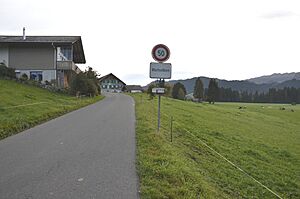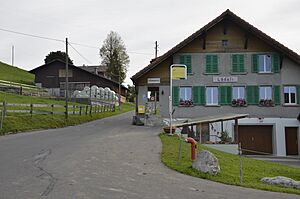Wachseldorn facts for kids
Quick facts for kids
Wachseldorn
|
||
|---|---|---|
|
||
| Country | Switzerland | |
| Canton | Bern | |
| District | Thun | |
| Area | ||
| • Total | 3.51 km2 (1.36 sq mi) | |
| Elevation | 990 m (3,250 ft) | |
| Population
(Dec 2020 )
|
||
| • Total | 229 | |
| • Density | 65.24/km2 (169.0/sq mi) | |
| Postal code |
3618
|
|
| Surrounded by | Buchholterberg, Oberlangenegg, Röthenbach im Emmental, Unterlangenegg | |
Wachseldorn is a small town, also known as a municipality, located in the beautiful country of Switzerland. It's part of the canton of Bern and is found in the Thun area.
Contents
Wachseldorn's Past: A Brief History
Wachseldorn was first mentioned in old records way back in 1293. It was called Wachseldorn even then!
Early Days and Changes
The farms and land that make up Wachseldorn today were once part of a larger area called Diessbach. In 1356, this land was given to a place called Interlaken Monastery.
Around 1399, the area was looked after by the Bernese Röthenbach court. Later, in 1528, the city of Bern changed its main religion to Protestantism. This led to the closing of Interlaken Monastery. Any land the monastery still had in Wachseldorn then went to Bern.
The next year, Wachseldorn became part of the bailiwick of Signau, which was a type of administrative area. Later, in 1864, it moved to the Thun District.
Merging and Separating Towns
In 1805, Wachseldorn and a nearby town called Buchholterberg decided to join together. But this didn't last long! They had some disagreements and decided to split up again in 1823. So, Wachseldorn became its own town once more.
School and Work Life
Wachseldorn was originally part of a large church area called Oberdiessbach. In 1860, it became part of the Buchholterberg church area.
Today, most jobs in Wachseldorn are in farming. However, many people travel to nearby Thun for work.
The first school in Wachseldorn was likely built in 1660. The current school building was built in 1957, on the same spot as an older school from 1832. A kindergarten was added in 1980. Sadly, the town council decided to close the main school on March 21, 2011, because not enough students were attending. The kindergarten is still open, but older students now go to school in Buchholterberg or Oberlangenegg.
Exploring Wachseldorn's Geography
Wachseldorn covers an area of about 3.51 square kilometers. That's about 1.36 square miles!
Land Use in Wachseldorn
A survey from 2006 showed how the land in Wachseldorn is used:
- About 70.5% of the land is used for farming.
- About 24.7% is covered by forests.
- About 5.1% has buildings or roads.
- A tiny bit, 0.3%, is rivers or lakes.
More specifically, 3.7% of the land has houses and buildings, and 1.4% has roads. About 23.6% of the land is dense forest, and 1.1% has orchards or small groups of trees. For farming, 17.9% is used for growing crops, and 51.4% is for pastures where animals graze. All the water in Wachseldorn is from flowing rivers or streams.
Villages and Mountains
The farms and small groups of houses that make up Wachseldorn are spread out around the Buchholterberg mountain. The main parts of the municipality are the villages of Wachseldorn-Dorf and Süderen.
On December 31, 2009, the old district of Amtsbezirk Thun was changed. The very next day, January 1, 2010, Wachseldorn became part of the new Verwaltungskreis Thun.
Wachseldorn's Coat of Arms
A coat of arms is like a special symbol for a town or family. Wachseldorn's coat of arms has a simple but clear design. It shows a black thorny branch with green leaves on a gold background.
Who Lives in Wachseldorn? Demographics
As of 2012, Wachseldorn has a population of 228 people. Only a small part, 0.9%, are people from other countries. Between 2010 and 2012, the number of people living in Wachseldorn stayed about the same.
Languages and Origins
As of 2000, everyone in Wachseldorn speaks German as their main language.
In 2013, about 51.9% of the people were male, and 48.1% were female. Most people (about 57.3% in 2000) were born in Wachseldorn and still lived there. About 33.8% were born in the same canton (Bern), and a few others were born elsewhere in Switzerland or outside Switzerland.
Age Groups
In 2012, here's how the population was divided by age:
- Children and teenagers (0–19 years old) made up 21.1% of the population.
- Adults (20–64 years old) made up 57.0%.
- Seniors (over 64 years old) made up 21.9%.
Family Life
In 2000, there were 123 single people in Wachseldorn who had never been married. There were 139 married people, 13 widows or widowers, and 6 divorced people.
In 2010, there were 25 homes with only one person living in them, and 10 homes with five or more people. In 2000, most apartments (89.0%) were lived in all the time.
Wachseldorn's Economy: How People Work
In 2011, Wachseldorn had a low unemployment rate of 2.58%. This means most people who wanted jobs had them.
Jobs in Wachseldorn
In 2011, there were 78 people working in Wachseldorn.
- Most jobs (53 people) were in the primary economic sector, which means farming. There were 23 businesses related to farming.
- No one was employed in the secondary sector (like manufacturing).
- The tertiary sector (service jobs) employed 25 people, with 12 businesses in this area.
Many people who live in Wachseldorn also work there. In 2000, 59 workers (about 78.7%) lived and worked in the municipality. However, more people leave Wachseldorn for work than come in.
Getting to Work
In 2000, about 9.3% of workers used public transportation to get to their jobs. A much larger number, 54%, used a private car.
Taxes and Income
Wachseldorn has some of the lowest local and cantonal tax rates in its canton. This means people living there pay less in taxes compared to many other places.
In 2010, 14 people in Wachseldorn earned over 75,000 CHF per year. The largest group of workers, 26 people, earned between 40,000 and 50,000 CHF per year.
Religion in Wachseldorn
Based on the 2000 census, most people in Wachseldorn (88.3%) belonged to the Swiss Reformed Church. A smaller number (3.2%) were Roman Catholic. Some people belonged to other Christian churches, and a few did not belong to any church.
Education in Wachseldorn
About 47.3% of the people in Wachseldorn have finished non-mandatory upper secondary education. This is like high school. About 6.9% have gone on to higher education, like university.
School System in Bern
The school system in the Canton of Bern works like this:
- One year of optional Kindergarten.
- Six years of Primary school.
- Three years of required lower Secondary school. Here, students are grouped by their abilities.
After lower Secondary school, students can continue their education or start an apprenticeship (learning a trade on the job).
During the 2012-2013 school year, 17 students attended kindergarten in Wachseldorn. A small number of these students (11.8%) were not Swiss citizens and spoke a different language at home than in the classroom.
In 2000, 18 students attended school in Wachseldorn. Eight of them lived and went to school in the municipality, while 10 came from other nearby towns. In the same year, 31 students from Wachseldorn went to schools outside the municipality.
See also
 In Spanish: Wachseldorn para niños
In Spanish: Wachseldorn para niños






